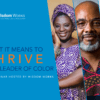[Guest blogger Nina Peterson, NCC, ACC is COO and partner at Wisdom Works. Previously she blogged about discipline, creative tension, and belt-tightening techniques.]
Decisions are a constant part of our lives and, at least for me, they seem to have been grabbing more of my attention lately. My son is facing a decision about his career. Myself, I’m prioritizing my personal time to choose the learning communities that best serve me. And professionally, I’m writing decision-making curriculum for one client while another client is deciding how to reorganize a department after staff changes. I was feeling a little emotionally exhausted after one particular day that included all four of these decision-making processes … and then along came some neuroscientists to say: “Of course you were!” It turns out emotions are – and should be – a part of our decision making.
One place for intriguing explorations on the subject is Jonah Lehrer’s book, How We Decide. I was surprised to discover that this was not an academic review of decision-making models, but rather a study of what neuroscience reveals about our long-held beliefs. One insight that Lehrer describes in his book (and in his TV interview with funnyman Stephen Colbert) is the critical role our emotions play in decision making. Emotions impacting decisions? That’s not how many of us were taught. Here’s a brief history of our cultural emphasis on rationality:
- Way back in the 4th century BC, Plato established a powerful foundation in Western culture by suggesting that logic – our rational mind – had to tame our wild and potentially destructive emotions.
- In the early 1600s, Descartes continued to embed this idea into our way of thinking by labeling emotions as crude and primitive.
- Developed in the 1960s, Kepner-Tregoe’s rational decision analysis remains a common form of management training.
The author Kurt Vonnegut once said: “I was taught that the human brain was the crowning glory of evolution so far, but I think it’s a very poor scheme for survival.” Assuming Vonnegut is referring to the classical view of the rational human brain, his quote, like Lehrer’s book, is pretty revolutionary. Recent studies, however, are supporting just such a revolution. Scientists studying brain function during decision making have identified a part of the brain that is responsible for integrating visceral emotions into the decision making process. They discovered, in fact, that without the ability to include emotions in the process, people are incapable of making a decision. Career consultant Anthony Spadafore goes into more detail in his blog “The Elephant in our Head.”
Experience is a fundamental building block for the brain. Learning what creates pleasure and what brings pain establishes an understanding of patterns. Think about deciding what to wear every day or which cereal to buy: if you did a complete analysis of all the options, you’d be stuck in “analysis paralysis.” The complexity of our world and the speed of life make it unreasonable to allow for deliberate, rational contemplation for every decision we must make. Thus enters emotion.
Emotions can provide a shortcut to decision making. When we are in familiar situations (whether through personal experience or research), our emotions cue the choice that has historically produced a positive outcome. Lehrer’s book shares stories of how an NFL quarterback and a military radar monitor both realize that there are times when their split-second decisions are driven not by rational thinking but by what feels right.
This revelation of the function of emotions does not abolish your obligation to develop good decision-making criteria, gather data, surface diverse perspectives, and complete cost/benefit analyses in certain circumstances. As business leaders with responsibility for strategic direction and optimal use of resources, you must use all the tools available to you. I encourage you to add awareness of emotional input to your tool box – especially when the stakes are high.
As for all those decision-making processes I was facing at the top of this entry, my feelings seem particularly relevant to one of them. In evaluating my association with different learning communities, I realized that my involvement is driven in part by the people involved (particularly those I care about) as well as the opportunity to stretch in new, sometimes uncomfortable ways. Trying to draw a conclusion solely from rational data would have been foolish: we’re talking about an investment of significant time and energy. I engaged my true feelings about the choices and decided to maintain my association with several of these communities.
And then my rational mind kicked in, telling me to try this for a year while paying more conscious attention to what needs of mine are being met and what results I’m achieving. That will provide the data for next year’s decision and then it’ll be time to get data and feelings together again for yet another go-round!
Photo by dierk schaefer





